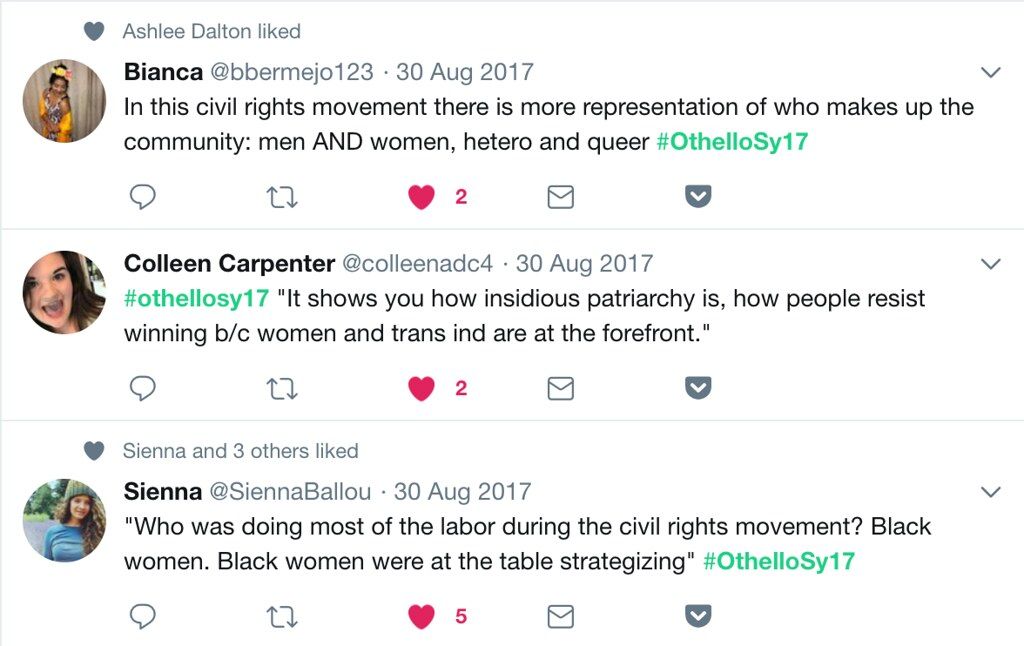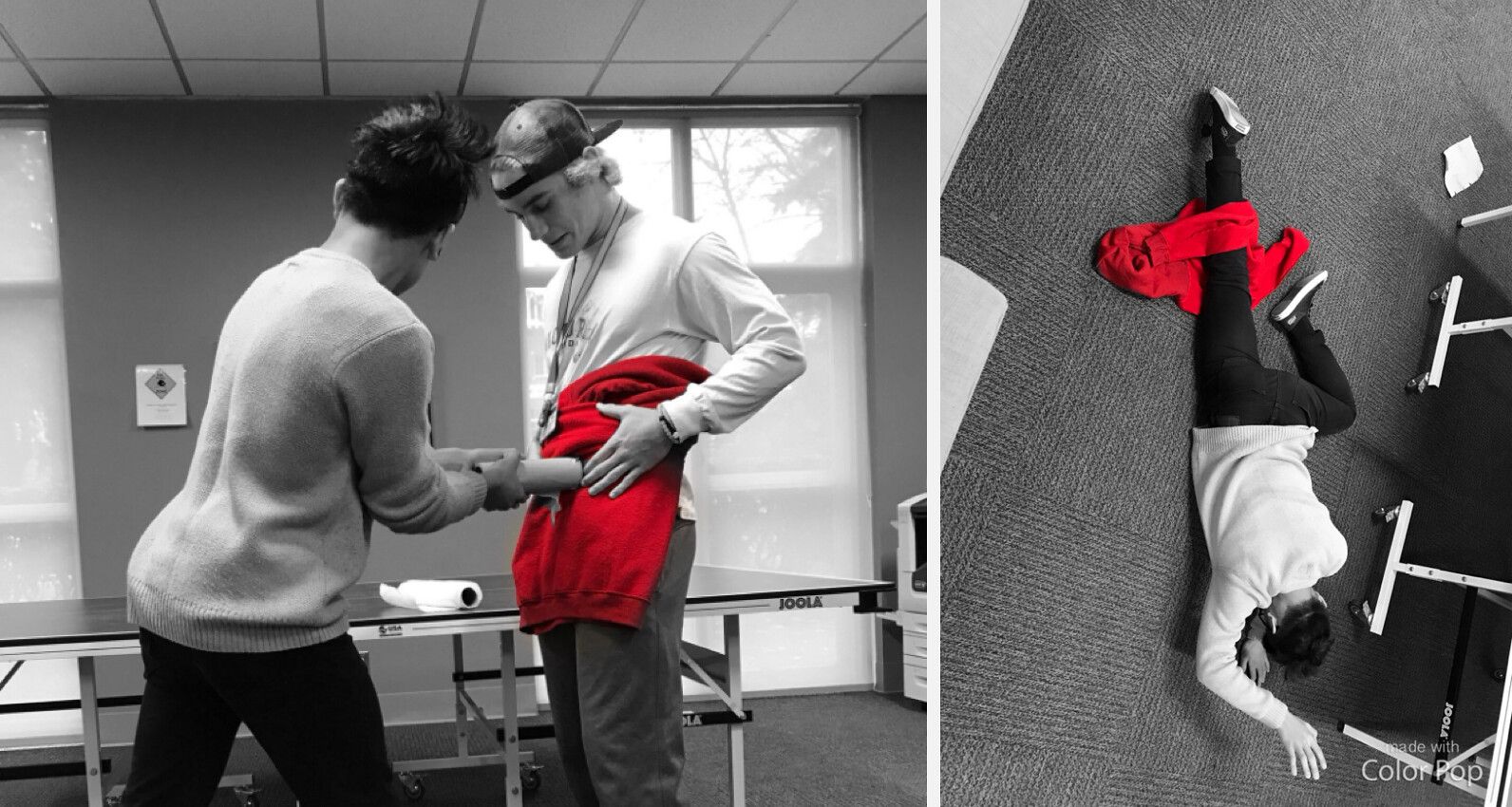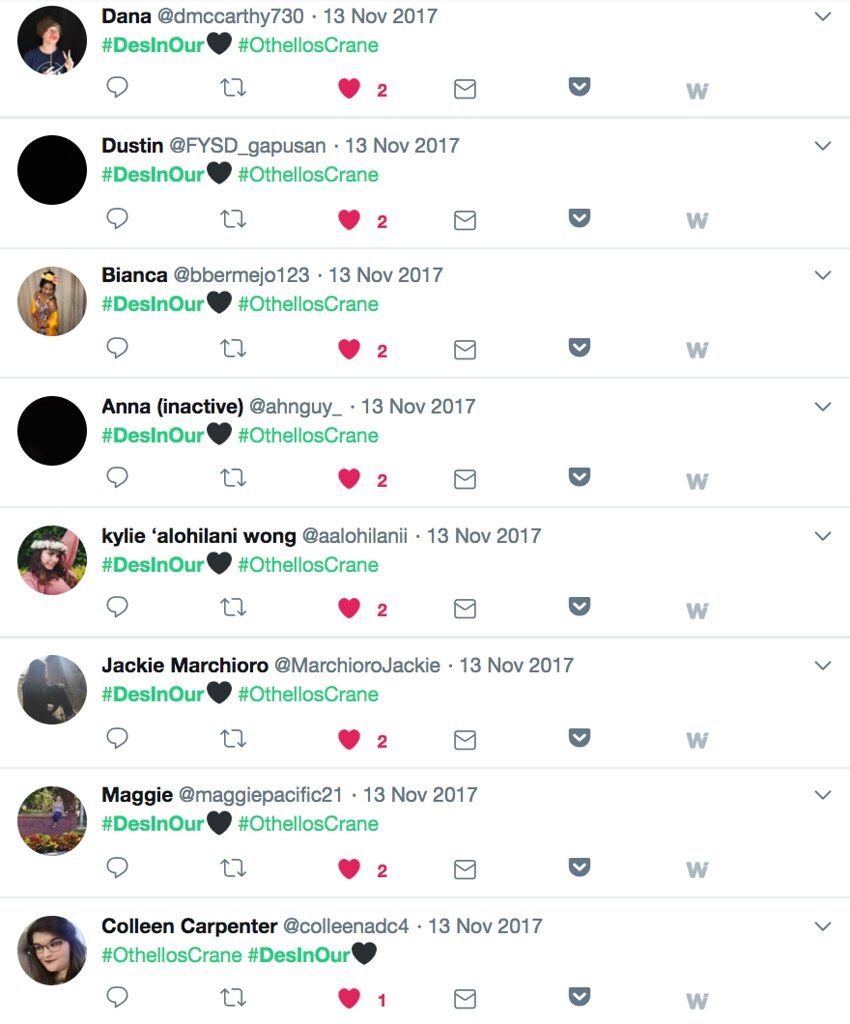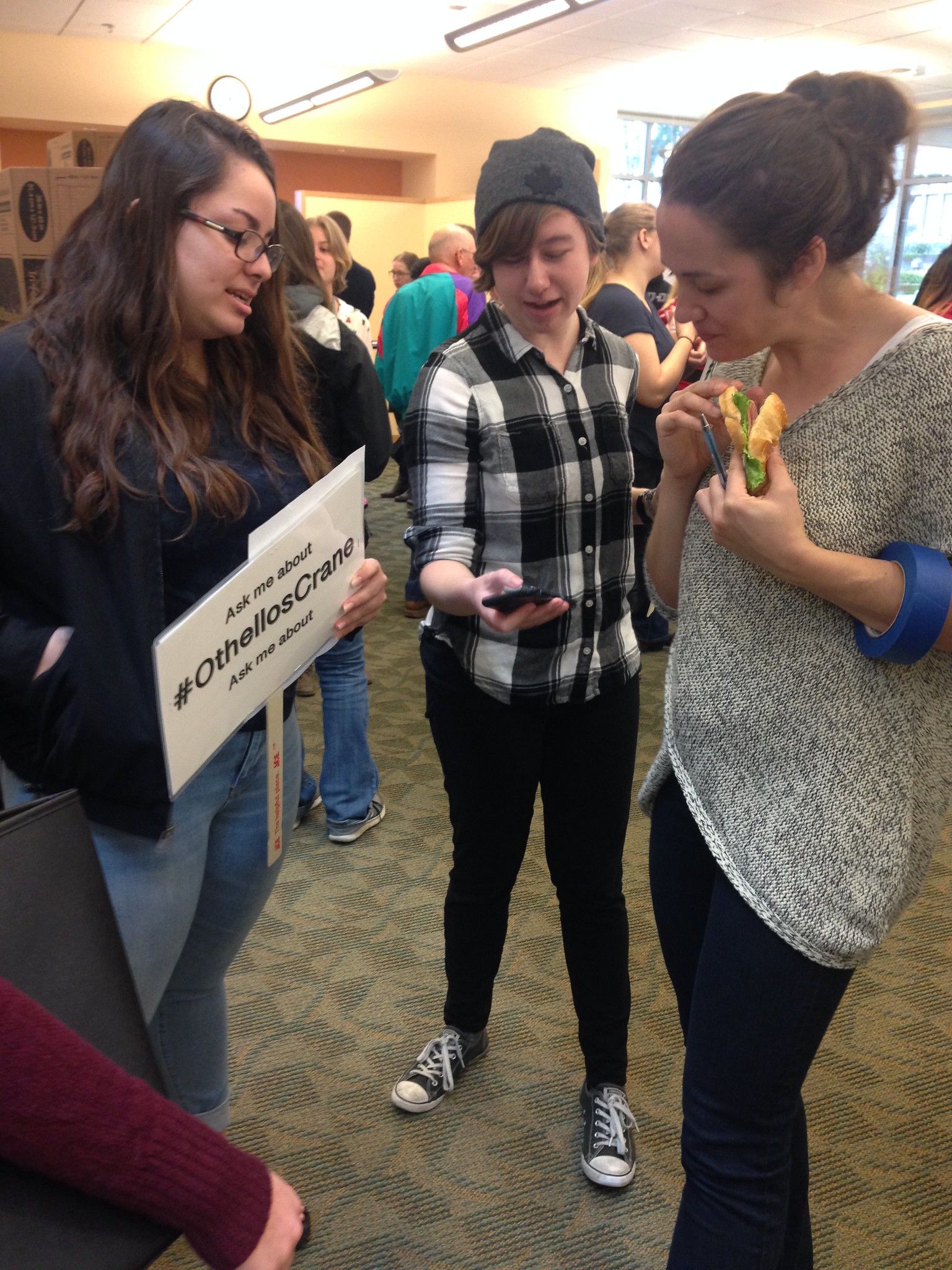Two guerrilla movements have disrupted Digital Humanities pedagogy in the past decade: the event syllabus, and the appropriation of Twitter as a composition genre. The event syllabus typically presents as a web-based archive of articles that help the public both instruct themselves about racialized violence and provides resources to teach a kind of cultural competency in the classroom from a specific case. Typically these begin with a call for public education through Twitter with hashtags such as #FergusonSyllabus, #OrlandoSyllabus or #PulseSyllabus, and #CharlestonSyllabus, the latter of which is now an edited collection from the University of Georgia Press. In our course, “#OthelloSyllabus: Cyprus, Ferguson, Forest Grove,” freshmen employed the rhetoric of hashtag activism to engage with critical race theory across a spectrum of texts, including a documentary on the Black Lives Matter (BLM) movement, William Shakespeare’s Othello, and Jordan Peele’s Get Out. In weekly twessays, posting responses during community lectures, and in devising a Twitter play, the platform’s paradoxical mix of anonymity and very public writing worked to develop in students a cultural competency.
The first-year seminar (or FYS) curriculum offers an ideal platform to engage public debates through digital tools. At Pacific University each section is provided an upper-class student to mentor and lead classes themselves. Our version of the course, supported by student mentor Sienna Ballou (a senior majoring in English Literature with minors in Spanish and Dance), was inspired by several events the previous academic year including the 2016 presidential election which hit undocumented peers hard, followed shortly by local police reports of a pick-up truck trolling campus with a sign reading “Black Lives Don’t Matter.” Then the TriMet attack on two young women of color happened in Portland. As a Shakespearean, there is an added moral obligation to consistently engage with the politics of identity from which one might otherwise easily hide intellectually behind the deadest, whitest guy on the block. From this self-conscious positionality, combined with imperative social events, #OthelloSyllabus was born. Through an articulation and reflection of the activities that used Twitter specifically to engage with issues of race in the course, this medium did, in fact, productively engage the complexity of a range of issues regarding race and digital activism.
In the fall of 2017, we opened our first-year seminar course with this sketch, “Othello Tis My Shite,” from a 2013 episode of the popular comedy show Key and Peele. The sketch is more historically accurate than perhaps the show writers realized: Of the nearly five hundred identifiable people of color living in Tudor England, black people were present in almost every area of London and its suburbs at some point between 1500 and 1677. Theatre historian Imtiaz Habib has shown that the black presence can be “documented in ninety percent of the neighborhoods dominated by the theatre industry” which critics now most closely associate with Shakespeare (268). Not only did the play-makers of Renaissance theatre live alongside people of color, but those neighbors very likely attended first performances of Othello as well as the two dozen other documented plays featuring characters of color—figures from all over the Mediterranean world. Aside from offering a gateway for cultural context, the sketch establishes for students that it is okay to playfully embrace the complexities of Shakespeare’s language. At the same time, the sketch makes clear that in order to develop social equality, as Paul Gorski and Katy Swalwell argue, it is necessary to stage stories that feature people of color, not just talk about their inequity

Hashtags in the Room
Our course experimented with the use of Twitter both in and out of the classroom, primarily offloading the practice of critical reading and evidence selection onto that platform. Enabling a wider range of participation amongst the students, in one-on-one conferences students routinely mentioned feeling safer participating in this way due to a perceived sense of anonymity in which to deal with an ideologically and emotionally difficult topic. Their words could be carefully chosen in a small extract rather than formulated in the huff and speed of verbal discussion. For example, the initial unit of the course was shaped around the questions of how forms of dichotomous rhetoric and argumentation undermine a community’s ability to communicate and collectivize. To set up this question as well as get students comfortable with using Twitter in the classroom, we watched the VPRO Backlight Series documentary on the BLM movement, which has its origins in the Seattle theatre scene. Rather than take notes, students pulled out their phones to post at least three tweets with the course hashtag #OthelloSy17 during and in response to questions posed by the documentary. It took about twenty minutes before an outgoing Music major posted an informational question about Treyvon Martin. More questions began to be posted, which evolved into incisive quotations from the film carefully composed for clarity and brevity. By the end of the session, students were actively sharing their own arguments in response to the film, and so extending the discussion beyond its initial conditions.
How do bodies get used—for something? against someone?—in the play? Use an emoji + short quotation. Make every character count. #OthelloSy17
— 𝔇𝔯. 𝔈𝔩𝔦𝔷𝔞𝔟𝔢𝔱𝔥 𝔈. 𝔗𝔞𝔳𝔞𝔯𝔢𝔰 (@ElizETavares) September 21, 2017
For 'twas that 🖐🏾 that gave away my ❤️. A liberal 🖐🏾! The 💞of old gave 👏🏽. #OthelloSy17
— kylie ✌︎('ω'✌︎ ) (@aalohilanii) September 23, 2017
"But I will wear my ❤️ upon my sleeve
— Dustin (@FYSD_gapusan) September 23, 2017
For daws to peck at: 👁 am not what I am." #OthelloSy17
After engaging one another through Twitter in the classroom, the students evolved these skills in their homework. Following the excellent work by Jesse Stommel and Donna Alexander, students created “twessays” to both strengthen concisions and develop arguable claims (as opposed to passive summary). Digital Humanist David Crystal has demonstrated that “all the popular beliefs about [short-form digital writing] are wrong, or at least debatable. Its graphic distinctiveness is not a totally new phenomenon. Nor is its use restricted to the young generation. There is increasing evidence that it helps rather than hinders literacy” (9). The twessay prompt was particularly successful in encouraging the production of a concrete idea with specific evidence because it asked for a very particular kind of observation. Sienna used one-on-one mentoring to encourage students to form questions about and from all available writing (including the tweets) so they could identify how textual evidence influenced these ideas. In one end-of-week discussion, we both wondered what kind of essays might be produced from students stringing together Twitter prompts as topic sentences. This is not to say that they did not also write formal essays, but in some ways the effectiveness of Twitter to deal with the kinds of exigencies that racialized public activism asks makes sense: these are new and newly difficult questions, so perhaps they require new and newly organized mediums.

#OthelloSy17 Iago's comments, such as "Barbary horse", show Othello as an aminal, something less than human. It can bias others' perceptions
— Cal McCarthy (@caldmccarthy) September 15, 2017
Iago's use of "anthropophagi" when he is discussing Othello's future children makes the reader think that they will be inhuman #othellosy17
— Ethan (@doan5590) September 15, 2017
The Strawberry Water Bottle
Getting students to take ownership over rather than reject out of hand very old words is difficult. In this forum, Twitter offered a useful avenue through which to apply devising techniques from the theatre industry in the classroom. Generally, devising activities ask participants to test all the available ways of performing a particular scene as licensed by the text with their bodies. In Literary Studies, it is known as polysemy: the simultaneous presence of multiple, equally viable readings of a literary text. We experimented with this in Othello and several professional adaptations of the story, including Red Velvet, a new play about the life of Ira Aldridge, the first person of color to play that eponymous role in 1825. (The question of blackface performance and Othello in particular is still very live as evidenced by blogger Michelle Villemaire’s photo-essay campaign, “My Adventures Correcting Yellowface.”) These devising exercises were crucial in order for students to fully consider the stakes of the cinema and alternate endings of the final text of the course, the Academy Award-winning Get Out. (Watch the original and alternate here.) Discussion of the two endings, how they engage the performance history of Othello and the ways in which they make audiences aware of their own biases surrounding police brutality, enabled students to articulate the extent to which performance choices matter — particularly when the stakes of the adaptation have purchase on issues of inclusion.
With the Royal Shakespeare Company Twitter play productions Such Tweet Sorrow (2010) and A Midsummer Night’s Dreaming (2013) as examples, for their final collaborative project the students developed #OthellosCrane, a modern retelling inspired by the town of Othello, Washington, a little less than five hours from their Forest Grove campus. Located in the heart of the Columbia Basin, Othello is home to the largest migration of Sandhill Cranes in the western hemisphere; thirty-five thousand of the birds, white and black with red face markings, return to Othello from Alaska every March. Unsettled by the thought that there was a town named Othello is a state founded on premises of exclusion of peoples of color and that remained segregated until late into the 1970s, the birds served as a poetic conceit and coordinating metaphor for their production.
Dramaturgy and devising activities in class facilitated students determining the major “beats” or plot elements that could not be left out in order for the basic story to hold together. Students used their own handles to perform different roles in each act over a five class-day period, or two weeks; most of the actual activity of performance took place over the course of the day outside of class time. The play famously opens with two men shouting racial epithets to Desdemona’s father in the wee hours of the night; the students started their play at roughly one in the morning to mimic that temporality which a traditional play could never do. They also had to make choices about props and how to translate early modern materials into modern ones. Particularly memorable was the strawberry stitched handkerchief that travels between characters, charting Desdemona’s chastity or presumed lack thereof. Instead, emulating the cultural specificity of the Pacific Northwest, students reimagined it as an insulated reusable water bottle decked with strawberry stickers.

The students were especially innovative in three areas, employing all of their knowledge about the intersectional complexities of the play. Informed by Critical Race Theory frameworks learned in class earlier in the semester, they first manipulated their Twitter profiles to emulate the emotional place of a specific character in a specific act in the play, including changing their display name, profile, and background images. Having developed skills in composing short statements where form and function reinforce a unified idea, these visual elements evolved over the course of the day a student was performing a role to take on more nuance and topicality. Using Kim F. Hall’s scholarship on the intersection of race and beauty in literature and visual culture of the Renaissance, students could then articulate how they used the palette of the profile to negotiate their own “fear of losing privilege” (474). We then discussed strategies they chose to indicate a specific character’s racial or gendered privileges and what evidence from the playtext justified their choice.
Iago: Shits about to go down 😈 #OthellosCrane pic.twitter.com/KYrB5pYbAP
— Jackie Marchioro (@MarchioroJackie) November 10, 2017
A unique problem to adapting Shakespeare to Twitter as opposed to, say, Frankenstein or The Picture of Dorian Gray was the need to replicate asides. The technique has a number of benefits, including cultivating a sense of privilege in audiences — that they have access to special knowledge — as well as interrogating power dynamics inherent to public and private speech. Much of the power behind Iago’s choices is negotiated through asides, but how to replicate them in the ostensibly one-dimensional linearity of Twitter? In a second stroke of inspiration, students used Twitter’s DM feature. Initially they had been messaging one another to strategize actions before posting the official tweets. This gave them the idea to orchestrate a private conversation between characters in the DM window, taking a screenshot of this private conversation between characters, and posting the images to the public Twitter thread to replicate the aside. In doing so, they maintained the visual cues that would mark this conversation as private, and yet make it public to the audience following along with the live Twitter thread.
DES: #MeToo #OthellosCrane
— Hannah Thornburg (@Han_Thornburg) November 10, 2017
Staged violence relies on physicality, which Twitter lacks. No student wanted an image of themselves aping violence on the Internet regardless of whether it was a performance. Professional productions have historically struggled with this ethical crux; as Erin Sullivan has argued, “the more life-like the production became, the more it moved away from the suspended ethics of fictional art and towards the codes of conduct expected, if not always realised, in the shared public sphere” (13). At one point in the play, Othello in his frustration and on the verge of another epileptic fit, not only slaps Desdemona but does so in a very public way that undermines his political authority as general of the Venetian army. After much deliberation, a brilliant solution emerged in discussion: students employed the #MeToo hashtag, only just then blossoming online in late fall of 2017, to suggest the violence without visualizing the action.

The final mass death scene at the end of the play, where five characters die, four in the same room, posed similar problems. Sienna worked with the students to devise a series of gestures and postures that would emulate the events, and then students used colorized photo apps on their phones to select only one color to present. In trying to figure out how to resolve the play, the students came up with an ingenious choice that employed the event syllabus genre, intervened in the ongoing #MeToo movement, and made clear the intersectionality of race and gender that was and has always been at stake in the resolution to the play.

The Other Side of the Handle
In order to fully merge the classroom and Twitter spheres—and by extension, the concepts learned in the course with life outside the course—#OthellosCrane needed an audience. As a final act of dissemination, the students participated in an end-of-term showcase wherein all the FYS course sections shared some kind of project. In the spirit of their play, rather than be tethered to a table or trifold, they made signs that read “Ask me about #OthellosCrane.” Moving between the other stationary presentations, they used pre-arranged, abbreviated scripts to share the play with their peers, discuss the experience of performing in it, and process what they learned about the intersection between gendered and racialized internal dominance. Because they could direct their peers to the hashtag, the play immediately traveled onto other phones and computers. The dissemination verbally and digitally was immediate and the click-rate hit more than six hundred individual users that day. Families, scholars, and other students around the country were checking in as well. The play has now been archived online, and you can read it with Wakelet.

In 2017, the context of Oregon’s overt whiteness as a state, recent racially-charged violence in the area, and its particular history of settler colonialism and racial expulsion merited, for us, the necessity of engaging with a seminal text of cultural difference. Engaging with any other topic within the sphere of identity politics seemed ideologically, pedagogically, and personally beside the point. While the performance of the play made clear the intersectional stakes pitting race against gender in Othello, its dissemination likewise made clear intersectional stakes pitting race against class. We could not have anticipated that such questions seem newly urgent in the wake of the summer of 2020, marked by a dramatic re-engagement with racialized police brutality and the “digital divide” driven, in part, by the novel coronavirus pandemic. As teachers and institutions at all levels race to find ways to meet students where they are in terms academic and technologic, instruments such as the twessay and Twitter play offer new and newly organized mediums by which students can formulate and particularize questions only newly difficult but certainly not new.

